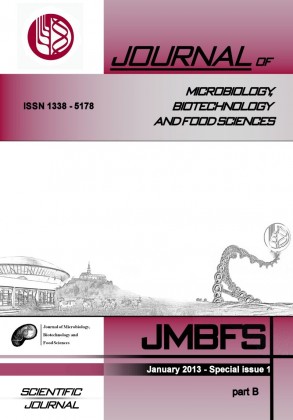DETECTION OF GENETIC DIVERSITY OF TRITICALE BY MICROSATELLITE MARKERS
Keywords:
triticale, SSR, genetic variability, PIC, dendrogramAbstract
The aim of our work was to detect genetic variability in the set of 59 winter and spring triticale (x Triticosecale Witt.) varieties using 5 wheat SSR markers. Totally, 35 alleles with an average number of 7 alleles per locus were detected. The highest number of alleles showed out Xbarc 004 (9). Based on the number and frequencies of alleles, the diversity index (DI), the probability of identity (PI) and the polymorphic information content (PIC) of SSR markers were calculated. The polymorphic information content (PIC) ranged from 0.264 to 0.920 with an average of 0.654, which is generally considered sufficient for this purpose. For the assessment of genetic diversity the dendrogram, based on the hierarchical cluster analysis using UPGMA algorithm was prepared. Fifty nine triticale cultivars were grouped into three major clusters. The cultivar Terelland 22 (USA) separated as unique one, second subcluster contained 3 cultivars and third one 55 cultivars. It was not possible to differentiate 15 genotypes between each other. For better differentiation it is necessary to use more polymorphic microsatellite markers. Results showed the utility of microsatellite markers for estimation of genetic diversity of triticale genotypes leading to genotype identification.Downloads
Download data is not yet available.
Downloads
Published
2013-02-01
How to Cite
Trebichalský, A., Balážová, ŽelmÃÂra, Gálová, Z., Chňapek, M., & Tomka, M. (2013). DETECTION OF GENETIC DIVERSITY OF TRITICALE BY MICROSATELLITE MARKERS . Journal of Microbiology, Biotechnology and Food Sciences, 2(special issue 1), 1898–1906. Retrieved from https://office2.jmbfs.org/index.php/JMBFS/article/view/7285
Issue
Section
Biotechnology
License
Copyright (c) 2013 Andrej Trebichalský, ŽelmÃÂra Balážová, Zdenka Gálová, Milan Chňapek, Marián Tomka

This work is licensed under a Creative Commons Attribution 4.0 International License.
All papers published in the Journal of Microbiology, Biotechnology and Food Sciences are published under a CC-BY licence (CC-BY 4.0). Published materials can be shared (copy and redistribute the material in any medium or format) and adapted (remix, transform, and build upon the material for any purpose, even commercially) with specifying the author(s).

